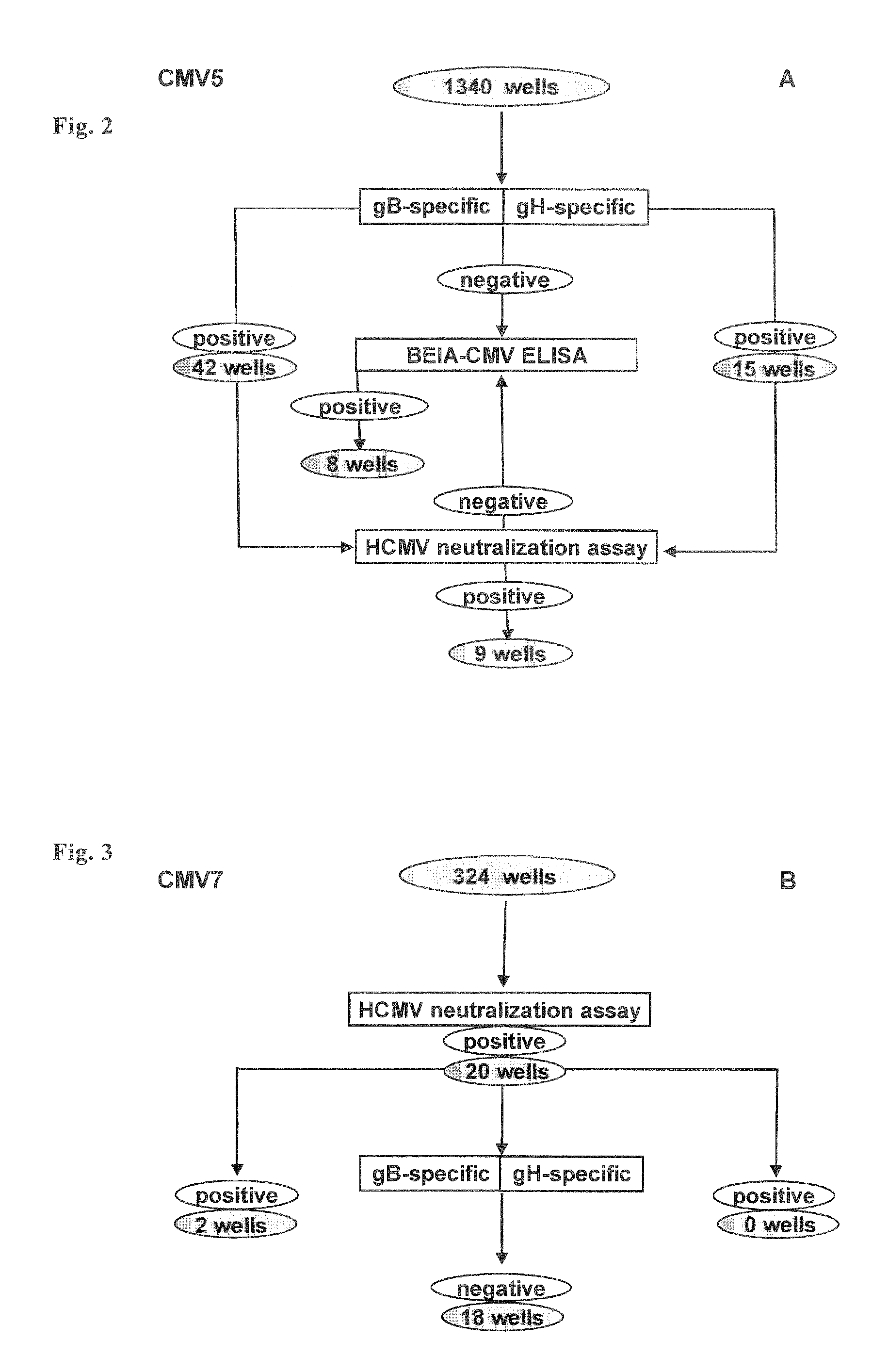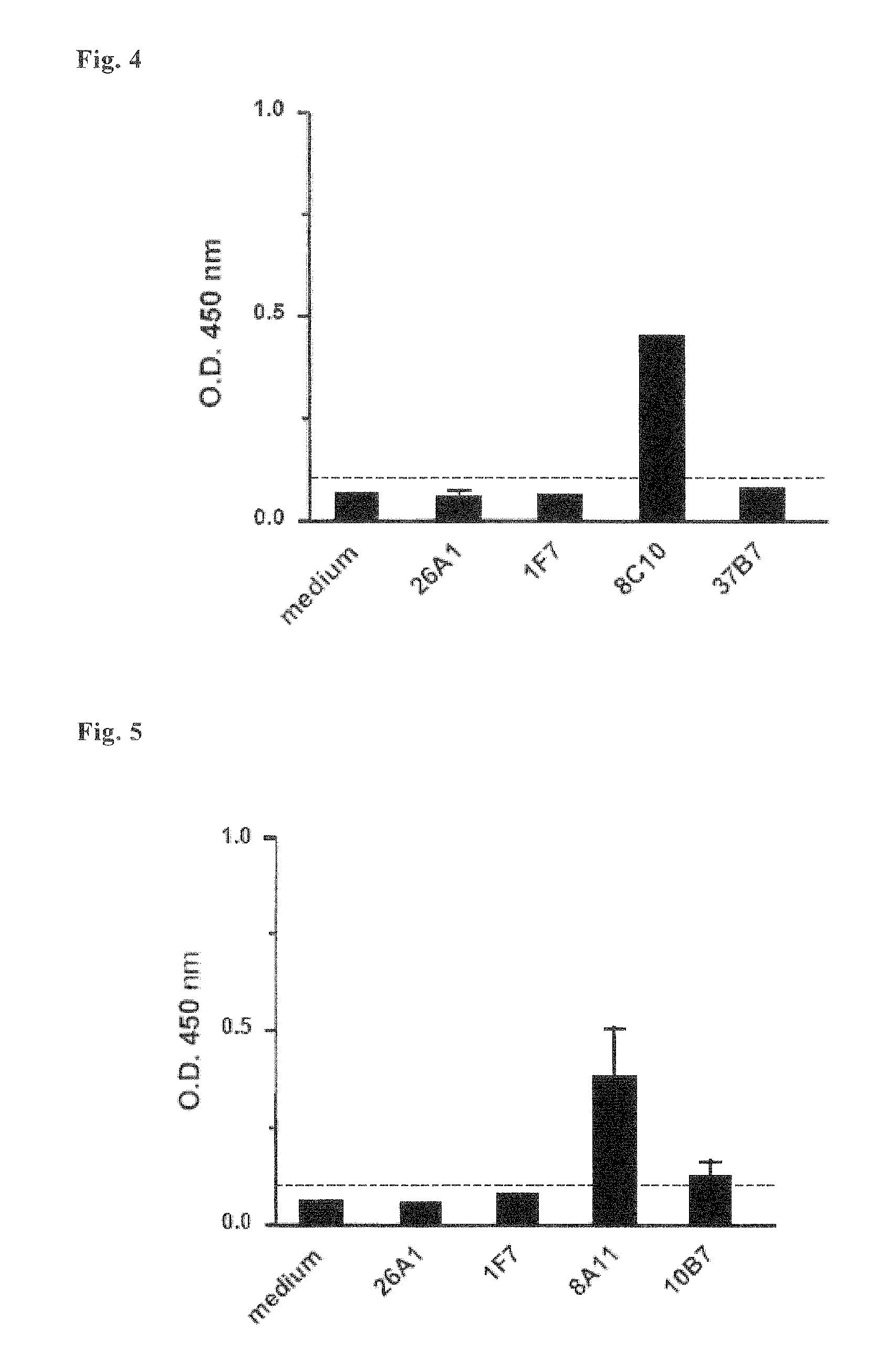Antibodies Against Human Cytomegalovirus (HCMV)
a technology of human cytomegalovirus and antibody sequence, which is applied in the field of antibody sequences, can solve the problems of poor oral bioavailability, difficult treatment of hcmv infections, and rare total clearance of hcmv
- Summary
- Abstract
- Description
- Claims
- Application Information
AI Technical Summary
Benefits of technology
Problems solved by technology
Method used
Image
Examples
example 1
Production of Cell Cultures Secreting Human Monoclonal Antibodies that Neutralize hCMV
Materials & Methods
Production of the Culture of Immortalized Human B Cells
[0102]Peripheral blood mononuclear cells (PBMCs) were obtained from an asymptomatic blood donor with high hCMV-specific IgG titer in the serum (CMV5). The hCMV-neutralizing antibodies were detected in the serum according to an hCMV microneutralization assay based on human Embryo Lung Fibroblasts (HELF cells) and AD169 (an hCMV laboratory strain from ATCC, cod. VR-538). The serum was also tested in an ELISA specific for human IgG binding hCMV virion proteins that is commercially available (BEIA-CMV IgG Quant; Bouty, Cat. No. 21465) and in an ELISA specific for human IgG binding gB(AD2) hCMV (Biotest, Cat. No. 807035; Rothe M et al., 2001; FIG. 1A. These hCMV-specific assays have been performed as outlined in WO 07 / 068758 or as indicated by the Manufacturer.
[0103]The EBV immortalization process to which PBMCs from CMV5 were sub...
example 2
Characterization of the 10B7 and 8A11 Antibodies
Materials and Methods
Characterization and Expansion of the 10B7 and 8A11 Subculture
[0111]The subclass of the antibodies secreted by the 10B7 and 8A11 subcultures was determined using a commercial assay (PeliClass human IgG subclass ELISA combi-kit; cod. RDI-M1551cib, RDI Divison of Fitzgerald Industries Intl.).
[0112]The 10B7 and 8A11 cell culture supernatants were tested in immunofluorescence on non-infected HUVEC cells. Briefly, HUVEC cells (7×104 / ml) were seeded on gelatine-coated glass-coverslips in 24-well plates in MEM added with 10% FCS and then grown to semi-confluency. Cells were then washed twice with warm PBS and then fixed with a pre-cooled (at −20° C.) mixture of 50% acetone / 50% methanol for 1 minute at room temperature (RT) and washed again with PBS. Fixed cells were permeabilized with 0.2% Triton X-100 in PBS for 20 minutes on ice, washed with PBS and incubated for 15 minutes at RT with a blocking solution (PBS added with...
example 3
Production of Cell Cultures Secreting Human Monoclonal Antibodies that Neutralize hCMV
Materials & Methods
Production of the Culture of Immortalized Human B Cells
[0125]Peripheral blood mononuclear cells (PBMCs) were obtained from a patient from an acute hCMV infection (CMV7) that was selected as presenting hCMV-neutralizing antibodies in the serum. The hCMV-neutralizing antibodies were detected according to an hCMV microneutralization assay based on human Embryo Lung Fibroblasts (HELF cells) and hCMV AD169 strain (an hCMV laboratory strain from ATCC, cod. VR-538). The serum was also tested in an ELISA specific for human IgG binding hCMV virion proteins that is commercially available (BEIA-CMV IgG Quant; Bouty, cod. 21465) and a gB (AD2) hCMV IgG ELISA, also commercially available and described in FIG. 1A (Biotest, cod. 807035, Rothe M et al., 2001) These hCMV-specific assays have been performed as outlined in WO 07 / 068758 or indicated by the Manufacturer.
[0126]The EBV immortalization ...
PUM
| Property | Measurement | Unit |
|---|---|---|
| concentration | aaaaa | aaaaa |
| concentration | aaaaa | aaaaa |
| concentration | aaaaa | aaaaa |
Abstract
Description
Claims
Application Information
 Login to View More
Login to View More - R&D
- Intellectual Property
- Life Sciences
- Materials
- Tech Scout
- Unparalleled Data Quality
- Higher Quality Content
- 60% Fewer Hallucinations
Browse by: Latest US Patents, China's latest patents, Technical Efficacy Thesaurus, Application Domain, Technology Topic, Popular Technical Reports.
© 2025 PatSnap. All rights reserved.Legal|Privacy policy|Modern Slavery Act Transparency Statement|Sitemap|About US| Contact US: help@patsnap.com



